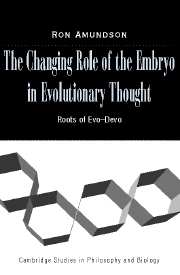Book contents
- Frontmatter
- Contents
- Acknowledgments
- 1 Introduction
- PART I DARWIN'S CENTURY: BEYOND THE ESSENTIALISM STORY
- 2 Systematics and the Birth of the Natural System
- 3 The Origins of Morphology, the Science of Form
- 4 Owen and Darwin, The Archetype and the Ancestor
- 5 Evolutionary Morphology: The First Generation of Evolutionists
- 6 Interlude
- PART II NEO-DARWIN'S CENTURY: EXPLAINING THE ABSENCE AND THE REAPPEARANCE OF DEVELOPMENT IN EVOLUTIONARY THOUGHT
- References
- Index
6 - Interlude
Published online by Cambridge University Press: 05 June 2012
- Frontmatter
- Contents
- Acknowledgments
- 1 Introduction
- PART I DARWIN'S CENTURY: BEYOND THE ESSENTIALISM STORY
- 2 Systematics and the Birth of the Natural System
- 3 The Origins of Morphology, the Science of Form
- 4 Owen and Darwin, The Archetype and the Ancestor
- 5 Evolutionary Morphology: The First Generation of Evolutionists
- 6 Interlude
- PART II NEO-DARWIN'S CENTURY: EXPLAINING THE ABSENCE AND THE REAPPEARANCE OF DEVELOPMENT IN EVOLUTIONARY THOUGHT
- References
- Index
Summary
TWO NARRATIVES OF THE HISTORY OF EVOLUTIONARY BIOLOGY
My engagement with Synthesis Historiography as a rhetorical adversary is at an end. SH formed the adversarial background against which the historical narrative of Part I was produced. Part II of my book is not be constructed against such a background. It is a straightforward attempt to understand the methodological arguments between structuralists and the Evolutionary Synthesis during the twentieth century. Before beginning the new century, let us summarize and deconstruct the implications of Part I. To some extent, the traditional SH narrative and my revisionist narrative are merely different ways of telling the story of the nineteenth century – yin and yang, the chicken and the egg. I want to acknowledge the ways in which this is true. I also want to point out the ways in which I believe that I have actually corrected the traditional narrative. First, some general differences in how a structuralist and a neo-Darwinian will approach a narrative of nineteenth-century biology.
ONE THEORY OR TWO?
A central difference is how to interpret Darwin's work. SH commentators will tend to see it as a unified whole, the theory of evolution by natural selection. Structuralist commentators will break Darwin's book into its parts, as did Dov Ospovat. Ospovat was a clear sympathizer with nineteenth-century structuralist biology (although I have no idea whether he was aware of its twentieth-century correlates). He introduced Darwin's own early division of his book into two parts, and I followed that division.
- Type
- Chapter
- Information
- The Changing Role of the Embryo in Evolutionary ThoughtRoots of Evo-Devo, pp. 130 - 136Publisher: Cambridge University PressPrint publication year: 2005

